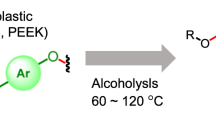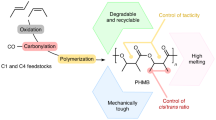Abstract
Bisphenol A (BPA) is an industrial chemical that has been used for the manufacturing of polycarbonate plastics, epoxy resins and other consumer products, including food contact materials and dental resins. However, its petrochemical origin and adverse health effects, such as xeno-oestrogenic activity (EA), pose a challenge for sustainability. Here we show a green synthetic pathway towards genuinely sustainable BPA alternatives from a renewable lignin source. At the heart of this production route is a selective alkylation reaction between bio-based arene (for example, guaiacol) and alkene (for example, isoeugenol) molecules, catalysed by a recyclable zeolite catalyst H-USY. Zeolite catalysis favours regioselectivity and prompts higher reaction rate and chemoselectivity, enabling high yields of bisguaiacols. The synthesized bisguaiacols can be valorized into high-molecular-weight thermoplastic and thermosetting polymers with promising thermophysical properties, showcasing their potential as BPA replacements. This work progresses beyond the state of the art by demonstrating that renewability is not only a goal but also a means for safer chemicals.
This is a preview of subscription content, access via your institution
Access options
Access Nature and 54 other Nature Portfolio journals
Get Nature+, our best-value online-access subscription
$29.99 / 30 days
cancel any time
Subscribe to this journal
Receive 12 digital issues and online access to articles
$119.00 per year
only $9.92 per issue
Buy this article
- Purchase on Springer Link
- Instant access to full article PDF
Prices may be subject to local taxes which are calculated during checkout





Similar content being viewed by others
Data availability
The data that support the findings of this study are reported within the Article and its Supplementary Information, and are available from the corresponding author upon request.
References
Schnell, H. Linear aromatic polyesters of carbonic acid. Ind. Eng. Chem. 51, 157–160 (1959).
Pham, H. Q. & Marks, M. J. in Ullmann’s Encyclopedia of Industrial Chemistry (eds Ley, C. et al.) 161–164 (Wiley-VCH, 2005).
Dodds, E. C. & Lawson, W. Synthetic estrogenic agents without the phenanthrene nucleus. Nature 137, 996 (1936).
Krishnan, A. V., Stathis, P., Permuth, S. F., Tokes, L. & Feldman, D. Bisphenol-A: an estrogenic substance is released from polycarbonate flasks during autoclaving. Endocrinology 132, 2279–2286 (1993).
Brotons, J. A., Olea -Serrano, M. F., Villalobos, M., Pedraza, V. & Olea, N. Xenoestrogens released from lacquer coatings in food cans. Environ. Health Perspect. 103, 608–612 (1995).
Corrales, J. et al. Global assessment of bisphenol A in the environment: review and analysis of its occurrence and bioaccumulation. Dose Response 13, 1559325815598308 (2015).
Howdeshell, K. L., Hotchkiss, A. K., Thayer, K. A., Vandenbergh, J. G. & vom Saal, F. S. Exposure to bisphenol A advances puberty. Nature 401, 763–764 (1999).
Nadal, A. Fat from plastics? Linking bisphenol A exposure and obesity. Nat. Rev. Endocrinol. 9, 9–10 (2013).
Heindel, J. J., Newbold, R. & Schug, T. T. Endocrine disruptors and obesity. Nat. Rev. Endocrinol. 11, 653–661 (2015).
Heindel, J. J. et al. Data integration, analysis, and interpretation of eight academic CLARITY-BPA studies. Reprod. Toxicol. 98, 29–60 (2020).
Vom Saal, F. S. & Vandenberg, L. N. Update on the health effects of bisphenol A: overwhelming evidence of harm. Endocrinology 162, bqaa171 (2021).
Eladak, S. et al. A new chapter in the bisphenol A story: bisphenol S and bisphenol F are not safe alternatives to this compound. Fertil. Steril. 103, 11–21 (2015).
Zimmerman, J. B. & Anastas, P. T. Toward substitution with no regrets. Science 347, 1198–1199 (2015).
Warner, G. R. & Flaws, J. A. Common bisphenol A replacements are reproductive toxicants. Nat. Rev. Endocrinol. 14, 691–692 (2018).
Soto, A. M., Schaeberle, C., Maier, M. S., Sonnenschein, C. & Maffini, M. V. Evidence of absence: estrogenicity assessment of a new food-contact coating and the bisphenol used in its synthesis. Environ. Sci. Technol. 51, 1718–1726 (2017).
Koelewijn, S.-F. et al. Sustainable bisphenols from renewable softwood lignin feedstock for polycarbonates and cyanate ester resins. Green Chem. 19, 2561–2570 (2017).
Koelewijn, S.-F. et al. Promising bulk production of a potentially benign bisphenol A replacement from a hardwood lignin platform. Green Chem. 20, 1050–1058 (2018).
Janvier, M. et al. Syringaresinol: a renewable and safer alternative to bisphenol A for epoxy-amine resins. ChemSusChem 10, 738–746 (2017).
Trita, A. S. et al. Synthesis of potential bisphenol A substitutes by isomerising metathesis of renewable raw materials. Green Chem. 19, 3051–3060 (2017).
Szafran, A. T., Stossi, F., Mancini, M. G., Walker, C. L. & Mancini, M. A. Characterizing properties of non-estrogenic substituted bisphenol analogs using high throughput microscopy and image analysis. PLoS ONE 12, e0180141 (2017).
Koelewijn, S.-F. et al. Regioselective synthesis, isomerisation, in vitro oestrogenic activity, and copolymerisation of bisguaiacol F (BGF) isomers. Green Chem. 21, 6622–6633 (2019).
Peng, Y., Nicastro, K. H., Epps, T. H. III & Wu, C. Methoxy groups reduced the estrogenic activity of lignin-derivable replacements relative to bisphenol A and bisphenol F as studied through two in vitro assays. Food Chem. 338, 127656 (2021).
Amitrano, A., Mahajan, J. S., Korley, L. T. & Epps, T. H. Estrogenic activity of lignin-derivable alternatives to bisphenol A assessed via molecular docking simulations. RSC Adv. 11, 22149–22158 (2021).
Vanholme, R., Demedts, B., Morreel, K., Ralph, J. & Boerjan, W. Lignin biosynthesis and structure. Plant Physiol. 153, 895–905 (2010).
Zakzeski, J., Bruijnincx, P. C. A., Jongerius, A. L. & Weckhuysen, B. M. The catalytic valorization of lignin for the production of renewable chemicals. Chem. Rev. 110, 3552–3599 (2010).
Ragauskas, A. J. et al. Lignin valorization: improving lignin processing in the biorefinery. Science 344, 1246843 (2014).
Rinaldi, R. et al. Paving the way for lignin valorisation: recent advances in bioengineering, biorefining and catalysis. Angew. Chem. Int. Ed. 55, 8164–8215 (2016).
Schutyser, W. et al. Chemicals from lignin: an interplay of lignocellulose fractionation, depolymerisation, and upgrading. Chem. Soc. Rev. 47, 852–908 (2018).
Sun, Z., Fridrich, B., de Santi, A., Elangovan, S. & Barta, K. Bright side of lignin depolymerization: toward new platform chemicals. Chem. Rev. 118, 614–678 (2018).
Renders, T., den Bosch, S. V., Koelewijn, S.-F., Schutyser, W. & Sels, B. F. Lignin-first biomass fractionation: the advent of active stabilisation strategies. Energy Environ. Sci. 10, 1551–1557 (2017).
Meier, D., Berns, J., Grünwald, C. & Faix, O. Analytical pyrolysis and semicontinuous catalytic hydropyrolysis of Organocell lignin. J. Anal. Appl. Pyrolysis 25, 335–347 (1993).
Onwudili, J. A. & Williams, P. T. Catalytic depolymerization of alkali lignin in subcritical water: influence of formic acid and Pd/C catalyst on the yields of liquid monomeric aromatic products. Green Chem. 16, 4740–4748 (2014).
Luo, H. et al. Total utilization of Miscanthus biomass, lignin and carbohydrates, using earth-abundant nickel catalyst. ACS Sustain. Chem. Eng. 4, 2316–2322 (2016).
Anderson, E. M. et al. Reductive catalytic fractionation of corn stover lignin. ACS Sustain. Chem. Eng. 4, 6940–6950 (2016).
Zhao, Z. & Moghadasian, M. H. Chemistry, natural sources, dietary intake and pharmacokinetic properties of ferulic acid: a review. Food Chem. 109, 691–702 (2008).
Chandra, G. et al. Alkoxy polycarbonates, bisphenol monomers and methods of making and using the same. US patent 9,120,893 (2015).
Trullemans, L. et al. A guide towards safe, functional and renewable BPA alternatives by rational molecular design: structure–property and structure–toxicity relationships. Polym. Chem. 12, 5870–5901 (2021).
Hernandez, E. D., Bassett, A. W., Sadler, J. M., La Scala, J. J. & Stanzione, J. F. Synthesis and characterization of bio-based epoxy resins derived from vanillyl alcohol. ACS Sustain. Chem. Eng. 4, 4328–4339 (2016).
Hambleton, K. M. & Stanzione, J. F. Synthesis and characterization of a low-molecular-weight novolac epoxy derived from lignin-inspired phenolics. ACS Omega 6, 23855–23861 (2021).
Cavani, F., Corrado, M. & Mezzogori, R. A note on the role of methanol in the homogeneous and heterogeneous acid-catalyzed hydroxymethylation of guaiacol with aqueous solutions of formaldehyde. J. Mol. Catal. A 182–183, 447–453 (2002).
De Vos, D. E. & Jacobs, P. A. Zeolite effects in liquid phase organic transformations. Microporous Mesoporous Mater. 82, 293–304 (2005).
Galkin, M. V. & Samec, J. S. M. Selective route to 2-propenyl aryls directly from wood by a tandem organosolv and palladium-catalysed transfer hydrogenolysis. ChemSusChem 7, 2154–2158 (2014).
Xiao, L.-P. et al. Catalytic hydrogenolysis of lignins into phenolic compounds over carbon nanotube supported molybdenum oxide. ACS Catal. 7, 7535–7542 (2017).
Martínez, C. & Corma, A. Inorganic molecular sieves: preparation, modification and industrial application in catalytic processes. Coord. Chem. Rev. 255, 1558–1580 (2011).
Grommet, A. B., Feller, M. & Klajn, R. Chemical reactivity under nanoconfinement. Nat. Nanotechnol. 15, 256–271 (2020).
Åqvist, J., Kazemi, M., Isaksen, G. V. & Brandsdal, B. O. Entropy and enzyme catalysis. Acc. Chem. Res. 50, 199–207 (2017).
Beste, A. & Buchanan, A. C. Computational study of bond dissociation enthalpies for lignin model compounds. Substituent effects in phenethyl phenyl ethers. J. Org. Chem. 74, 2837–2841 (2009).
Liu, P., Zeng, L., Ye, G. & Xu, J. Bisphenol A-based co-polyarylates: synthesis, properties and thermal decomposition mechanism. J. Polym. Res. 20, 279 (2013).
Curia, S. et al. Towards sustainable high‐performance thermoplastics: synthesis, characterization, and enzymatic hydrolysis of bisguaiacol‐based polyesters. ChemSusChem 11, 2529–2539 (2018).
Witters, H. et al. The assessment of estrogenic or anti-estrogenic activity of chemicals by the human stably transfected estrogen sensitive MELN cell line: results of test performance and transferability. Reprod. Toxicol. 30, 60–72 (2010).
Vandermarken, T. et al. Characterisation and implementation of the ERE-CALUX bioassay on indoor dust samples of kindergartens to assess estrogenic potencies. J. Steroid Biochem. Mol. Biol. 155, 182–189 (2016).
Kuhire, S. S., Nagane, S. S. & Wadgaonkar, P. P. Pendant furyl containing bisphenols, polymers therefrom and a process for the preparation thereof. WO patent 2015140818A4 (2015).
Ping, Z., Linbo, W. & Bo-Geng, L. Thermal stability of aromatic polyesters prepared from diphenolic acid and its esters. Polym. Degrad. Stab. 94, 1261–1266 (2009).
Acknowledgements
B.F.S. thanks the KU Leuven industrial research fund (C32/18/021 to L.T. and S.-F.K.). This work was performed in the framework of the Catalisti Cluster cSBO project PADDL, with the financial support of VLAIO HBC.2019.0118, within the iBOF programme Next-BIOREF project 20-VLIR-iBOF-026 (T.H., G.P. and H.W.) and the EOS project BIOFACT 30902231 (E.C.). I.B. and M.E. were supported by Research Foundation Flanders project G089016N of the Free University of Brussels (VUB). We thank D. Kerstens for the zeolite characterization and B. Van Meerbeek of the department BIOMAT at KU Leuven for help with the Vickers hardness tests (KU Leuven infrastructure funding KA/20/079).
Author information
Authors and Affiliations
Contributions
S.-F.K., L.T. and B.F.S. conceived and directed the project. S.-F.K. and L.T. carried out key experiments and wrote the manuscript. G.P. synthesized the polycarbonates. I.B. and M.E. performed the CALUX bioassay. T.H. and H.W. performed the MELN bioassay. H.W., I.B. and M.E. performed the in vitro EA screenings. E.C. and J.V.A. carried out the adapted RCF experiments. P.V.P. contributed to the screening and analysis of thermal properties and M.D. to the kinetic experimental design. All authors discussed the results and commented on the manuscript.
Corresponding authors
Ethics declarations
Competing interests
Patent applications (WO/2018/134427, WO/2019/002503) are pending or granted for inventors S.-F.K. and B.F.S. (US/EP/CN). The remaining authors declare no competing interests.
Peer review
Peer review information
Nature Sustainability thanks Guoyong Song and Bert M. Weckhuysen for their contribution to the peer review of this work.
Additional information
Publisher’s note Springer Nature remains neutral with regard to jurisdictional claims in published maps and institutional affiliations.
Supplementary information
Supplementary Information
Supplementary Materials and Methods, figures, tables and references.
Rights and permissions
Springer Nature or its licensor (e.g. a society or other partner) holds exclusive rights to this article under a publishing agreement with the author(s) or other rightsholder(s); author self-archiving of the accepted manuscript version of this article is solely governed by the terms of such publishing agreement and applicable law.
About this article
Cite this article
Trullemans, L., Koelewijn, SF., Boonen, I. et al. Renewable and safer bisphenol A substitutes enabled by selective zeolite alkylation. Nat Sustain 6, 1693–1704 (2023). https://doi.org/10.1038/s41893-023-01201-w
Received:
Accepted:
Published:
Issue Date:
DOI: https://doi.org/10.1038/s41893-023-01201-w
This article is cited by
-
A sustainable alternative to bisphenol A
Nature Sustainability (2023)



